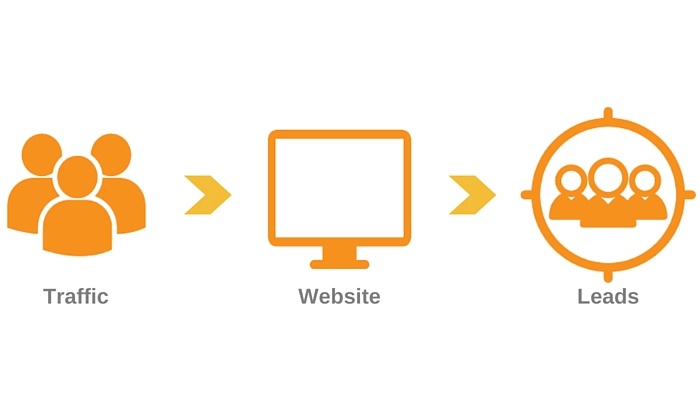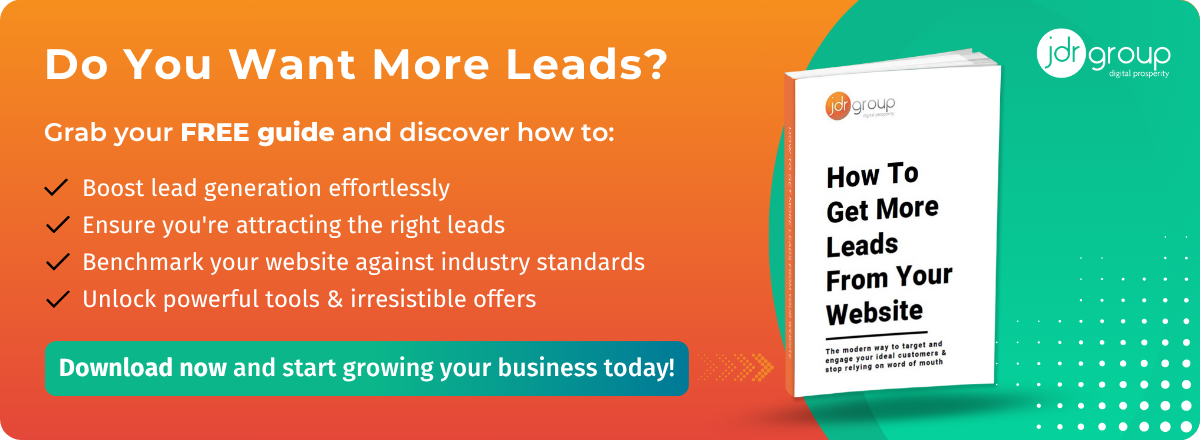Turning Browsers Into Buyers: Effective Website Lead Generation Strategies For Small Business Owners
by Will Williamson on 29-Jun-2023 12:30:00

For high-street retailers, encouraging people off the street to browse the shelves is just the first part of the story. The real job is to prompt them to move from the shelf to the till! The same is true for online businesses, whether B2C or B2B. Once you encourage people to visit your website, great, you’ve got an opportunity to convert them into leads, but how do you progress them along that journey to becoming customers?
In this article, we’ll look at effective lead conversion strategies that will help encourage your website browsers to take that crucial next step.
1. Create Compelling Content
Web content is crucial for making conversions. You need to create mixed media content for each page that provides genuine value to your audience and resonates with your target market. This doesn’t have to be rocket science, just research the search queries/keywords that might draw your ideal customer to a particular page and answer these questions in a clear and concise way.
Make your content actionable, informative, engaging, and relevant to your niche. High-quality content positions your business as an authority in your industry, making them more likely to want to find out more. However, it’s important to note that writing web content is not the same as writing blog articles. Web content should be far more concise and broken down into lots of short paragraphs and bullet point lists with informative H2 headings to enable readers to quickly ‘skim’ the information they need. A large wall of text is more likely to deter a visitor than encourage a lead.
2. Use Landing Pages
Landing pages are concise, simple web pages designed and optimised for conversions. Unlike your pillar pages, which will typically cover a large amount of information, landing pages are focused on a single keyword, product, or promotion. The information on your landing pages should be clear and super-concise, with a strong call to action (CTA) throughout all the content with a short form in exchange for a free downloadable guide/brochure, demo, or to send a query – this form will help capture that lead information. They should be optimised for mobile devices, minimise distractions with no navigation or limited navigation away from the page, and include trust signals like testimonials and/or certification badges that matter to your ideal customers.
3. Publish Social Proof On Each Page
People want to do business with a company they can trust, but how do they know if they can trust you? That answer is simple – because other people have placed their trust in you before. Social proof is based on the psychological principle that people tend to follow the actions of others. By showcasing social proof on all key pages of your website in the form of testimonials, case studies, ratings and reviews from Google, browsers can see that others have had a positive experience with your business. Awards, professional memberships, and certifications are also strong measures of social proof, especially in the B2B market.
4. Implement A Live Chat Feature
A live chat feature allows browsers to ask questions about your products and services in real time, usually via an AI Chatbot – think of it as a virtual robot shop assistant. Customers can ask questions and get immediate answers from the AI without having to wait for a response via email. The live chat feature can also track the movement of browsers around your website and provide insights into their interests and priorities. Remember, to really hone in that trust, this bot should always have the ability to transfer the user to a member of your team in case the bot is unable to answer their queries, levelling up that trust and giving this feature a personal touch.
5. Use lead capture forms
Lead capture forms allow you to request your website visitors' contact information, such as their name, email address, and phone number. You can then use this data to nurture them through the sales funnel and convert them into paying customers, e.g. through email marketing. To make it as easy as possible for customers to give you the means to keep in touch before they leave your website, place a lead capture form on all necessary pages of your site, not just the ‘Contact page’ or landing pages; this includes, service pages, your blog page so the browser can subscribe for more, etc. If there isn’t a relevancy on a page for a form, use a CTA button on each page that the user can follow to bring them to a landing page or the contact page, encouraging them to convert into a lead.
What’s Next?
Our website conversion services at JDR Group can help you increase lead generation and sales conversion for your business. To find out more, please get in touch or download our free guide all about how to generate leads from your website, today.
Image Source: Pexels
- Inbound Marketing (SEO, PPC, Social Media, Video) (823)
- Strategy (361)
- Sales & CRM (193)
- Marketing Automation & Email Marketing (190)
- Business Growth (162)
- Website Design (160)
- Hubspot (137)
- Lead Generation (115)
- Google Adwords (98)
- Content Marketing (94)
- Conversion (48)
- Case Studies (47)
- News (47)
- Ecommerce (39)
- Webinars (34)
- SEO (24)
- AI (19)
- Events (19)
- Video (17)
- LinkedIn Advertising (15)
- Video Selling (15)
- Software training (13)
- Niche business marketing (11)
- The Digital Prosperity Podcast (10)
- Facebook Advertising (6)
- HubSpot Case Studies (5)
- December 2025 (7)
- November 2025 (6)
- October 2025 (17)
- September 2025 (16)
- August 2025 (14)
- July 2025 (14)
- June 2025 (5)
- May 2025 (19)
- April 2025 (15)
- March 2025 (13)
- February 2025 (13)
- January 2025 (8)
- December 2024 (2)
- November 2024 (4)
- October 2024 (21)
- September 2024 (4)
- August 2024 (8)
- July 2024 (14)
- June 2024 (16)
- May 2024 (25)
- April 2024 (15)
- March 2024 (18)
- February 2024 (5)
- January 2024 (10)
- December 2023 (6)
- November 2023 (10)
- October 2023 (13)
- September 2023 (12)
- August 2023 (14)
- July 2023 (13)
- June 2023 (14)
- May 2023 (15)
- April 2023 (13)
- March 2023 (14)
- February 2023 (13)
- January 2023 (15)
- December 2022 (13)
- November 2022 (6)
- October 2022 (8)
- September 2022 (22)
- August 2022 (15)
- July 2022 (13)
- June 2022 (16)
- May 2022 (14)
- April 2022 (16)
- March 2022 (17)
- February 2022 (11)
- January 2022 (8)
- December 2021 (6)
- November 2021 (7)
- October 2021 (11)
- September 2021 (10)
- August 2021 (7)
- July 2021 (7)
- June 2021 (4)
- May 2021 (4)
- April 2021 (1)
- March 2021 (3)
- February 2021 (5)
- January 2021 (4)
- December 2020 (7)
- November 2020 (6)
- October 2020 (5)
- September 2020 (9)
- August 2020 (18)
- July 2020 (17)
- June 2020 (17)
- May 2020 (10)
- April 2020 (21)
- March 2020 (24)
- February 2020 (21)
- January 2020 (12)
- December 2019 (23)
- November 2019 (12)
- October 2019 (14)
- September 2019 (16)
- August 2019 (15)
- July 2019 (13)
- June 2019 (6)
- May 2019 (8)
- April 2019 (4)
- March 2019 (2)
- February 2019 (2)
- January 2019 (2)
- December 2018 (3)
- November 2018 (24)
- September 2018 (11)
- August 2018 (9)
- June 2018 (3)
- May 2018 (6)
- April 2018 (14)
- March 2018 (12)
- February 2018 (16)
- January 2018 (15)
- December 2017 (15)
- November 2017 (18)
- October 2017 (23)
- September 2017 (19)
- August 2017 (28)
- July 2017 (27)
- June 2017 (25)
- May 2017 (18)
- April 2017 (17)
- March 2017 (16)
- February 2017 (17)
- January 2017 (14)
- December 2016 (21)
- November 2016 (27)
- October 2016 (25)
- September 2016 (16)
- August 2016 (20)
- July 2016 (19)
- June 2016 (14)
- May 2016 (20)
- April 2016 (24)
- March 2016 (22)
- February 2016 (28)
- January 2016 (27)
- December 2015 (28)
- November 2015 (19)
- October 2015 (9)
- September 2015 (12)
- August 2015 (5)
- July 2015 (1)
- June 2015 (10)
- May 2015 (3)
- April 2015 (11)
- March 2015 (14)
- February 2015 (15)
- January 2015 (12)
- December 2014 (2)
- November 2014 (23)
- October 2014 (2)
- September 2014 (2)
- August 2014 (2)
- July 2014 (2)
- June 2014 (7)
- May 2014 (14)
- April 2014 (14)
- March 2014 (7)
- February 2014 (2)
- January 2014 (7)
- December 2013 (9)
- November 2013 (14)
- October 2013 (17)
- September 2013 (3)
- August 2013 (6)
- July 2013 (8)
- June 2013 (4)
- May 2013 (3)
- April 2013 (6)
- March 2013 (6)
- February 2013 (7)
- January 2013 (5)
- December 2012 (3)
- November 2012 (2)
- September 2012 (1)
Subscribe by email
You May Also Like
These Related Blogs

How To Create A Lead Generating Website – Six Steps To Follow
Your website can be a highly effective tool for generating leads if designed with lead generation in mind. There are several ways to optimise your web …

9 Reasons Why Most Website Visitors Leave Without Buying
Increasing traffic to your website is the first vital step in making more sales online, but the disappointing truth is that most website visitors leav …

Should I Design My Own Website?
I meet new business people and look at their websites nearly every day. I see business owners who have spent £50,000 on their site, I meet business ow …




